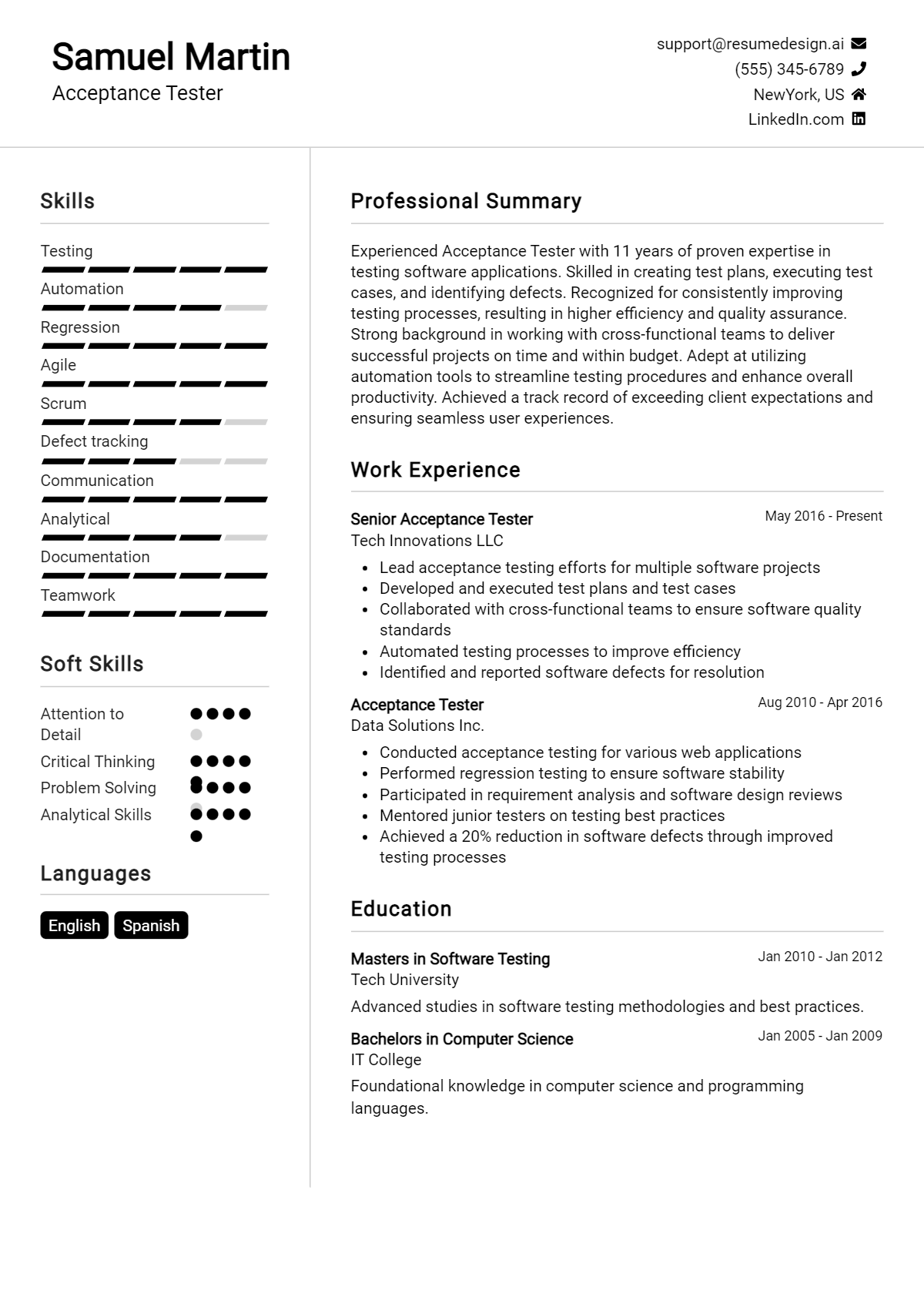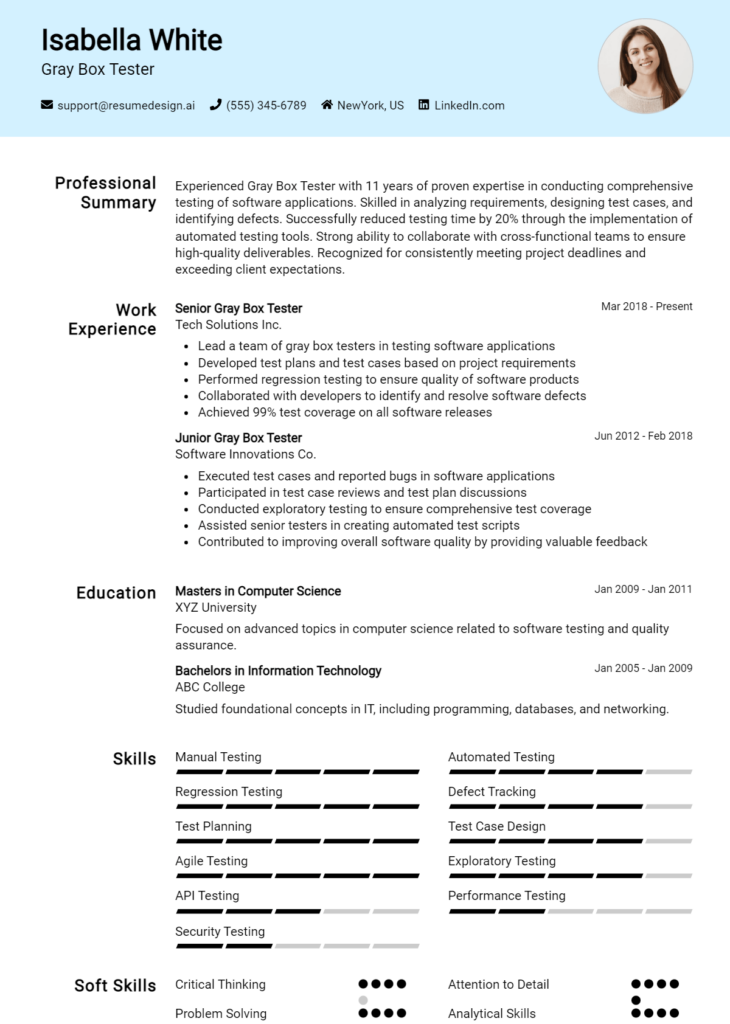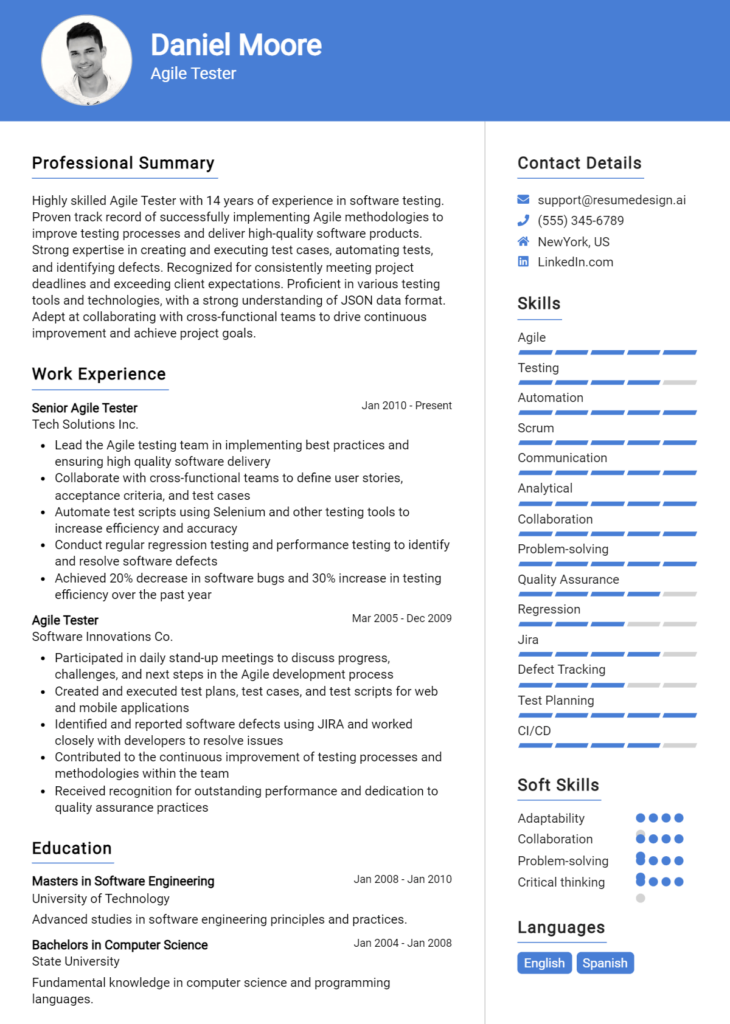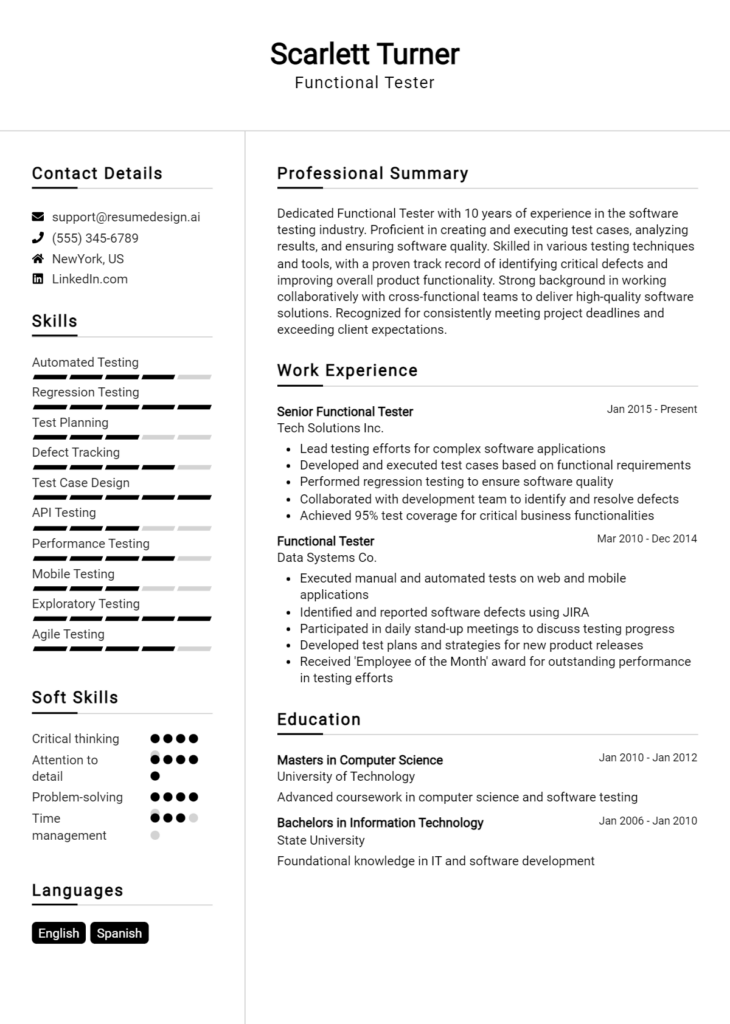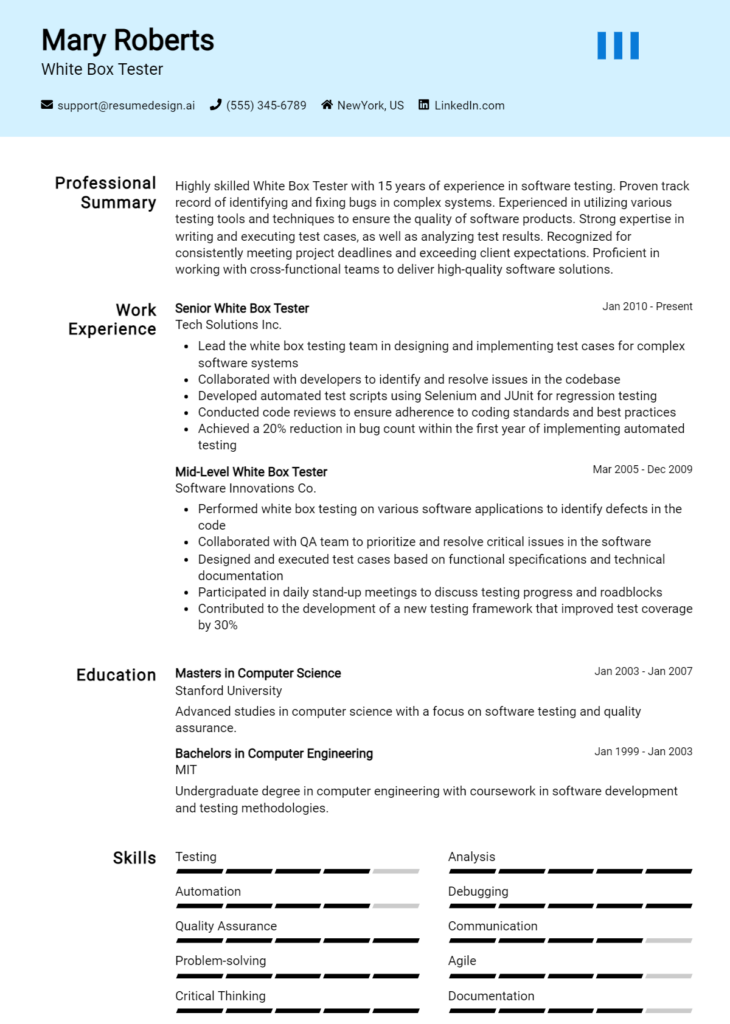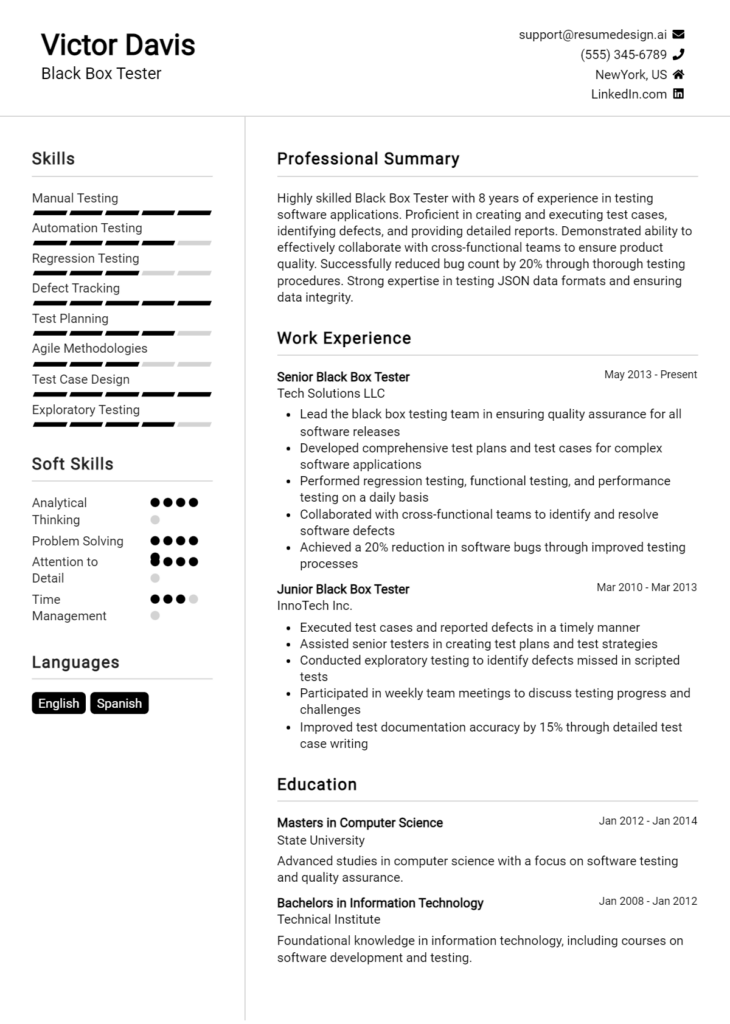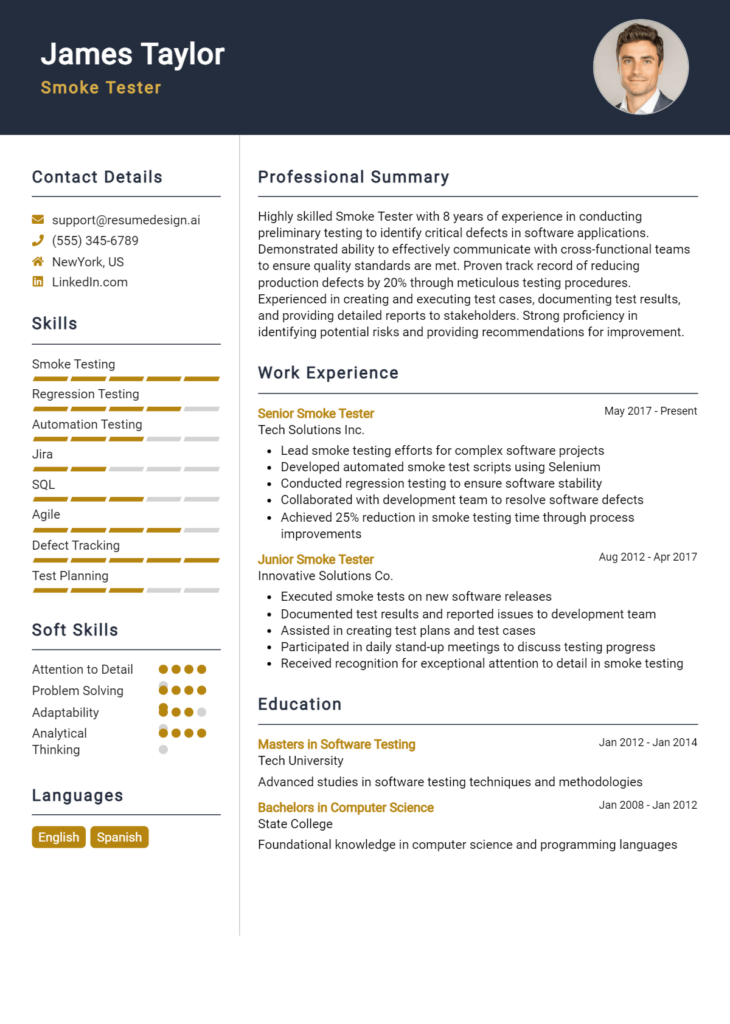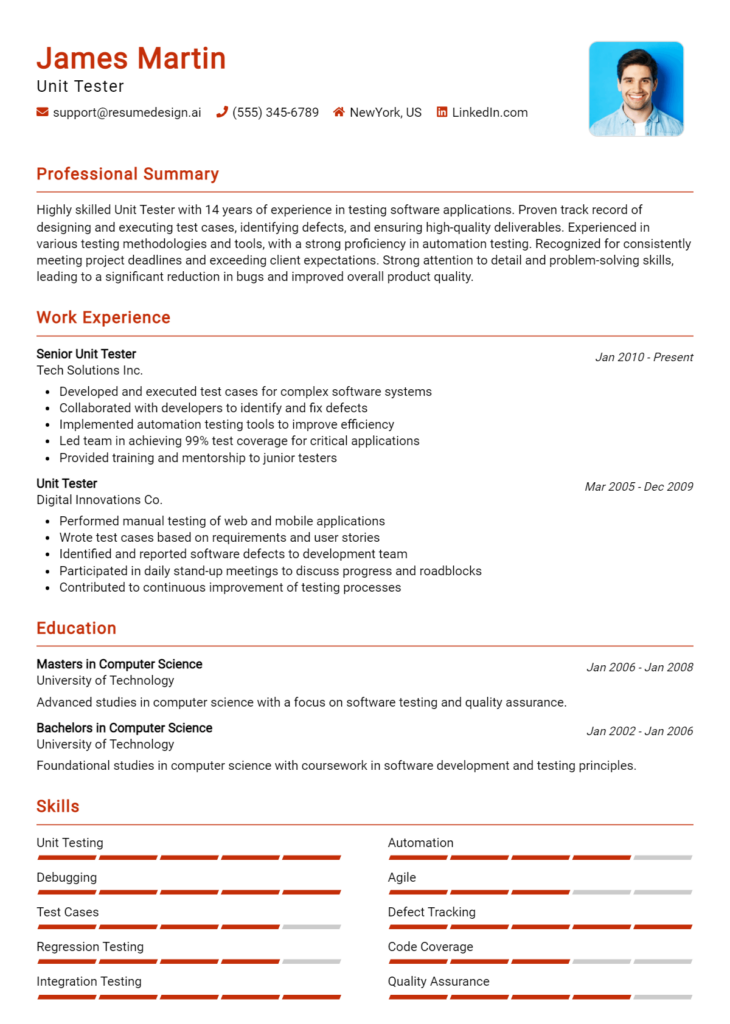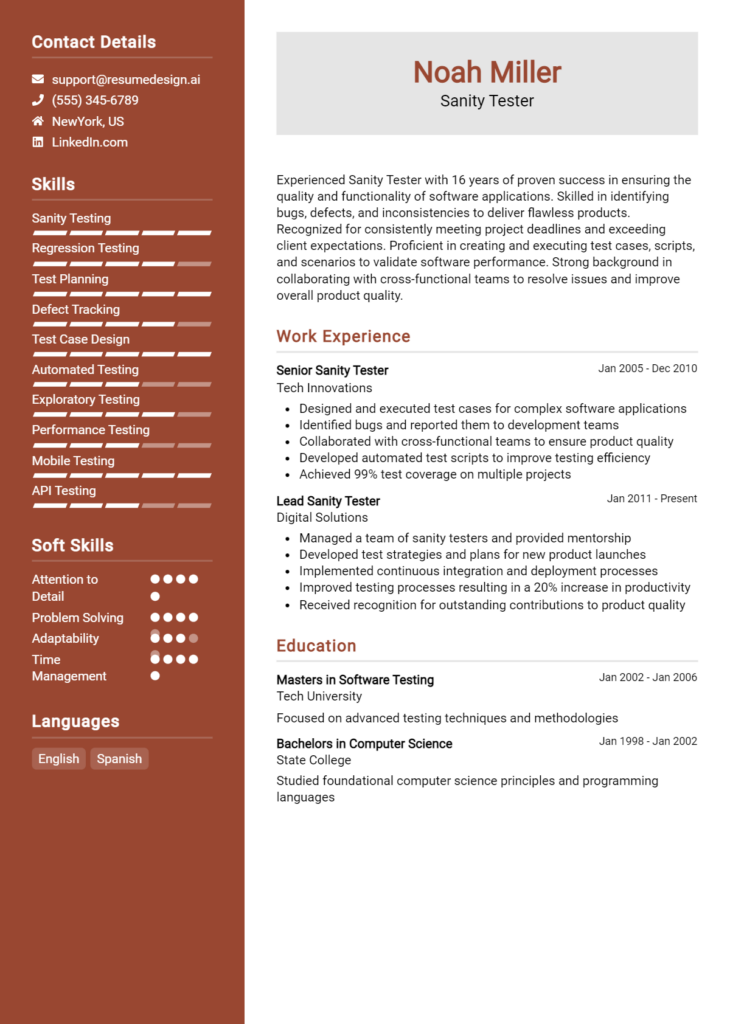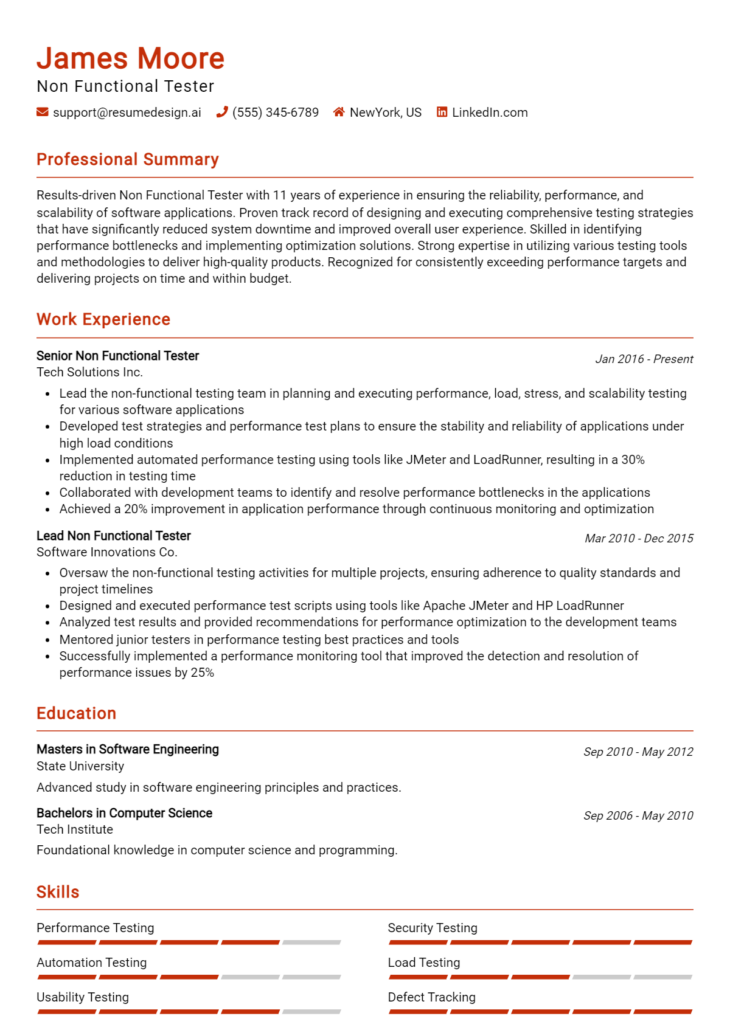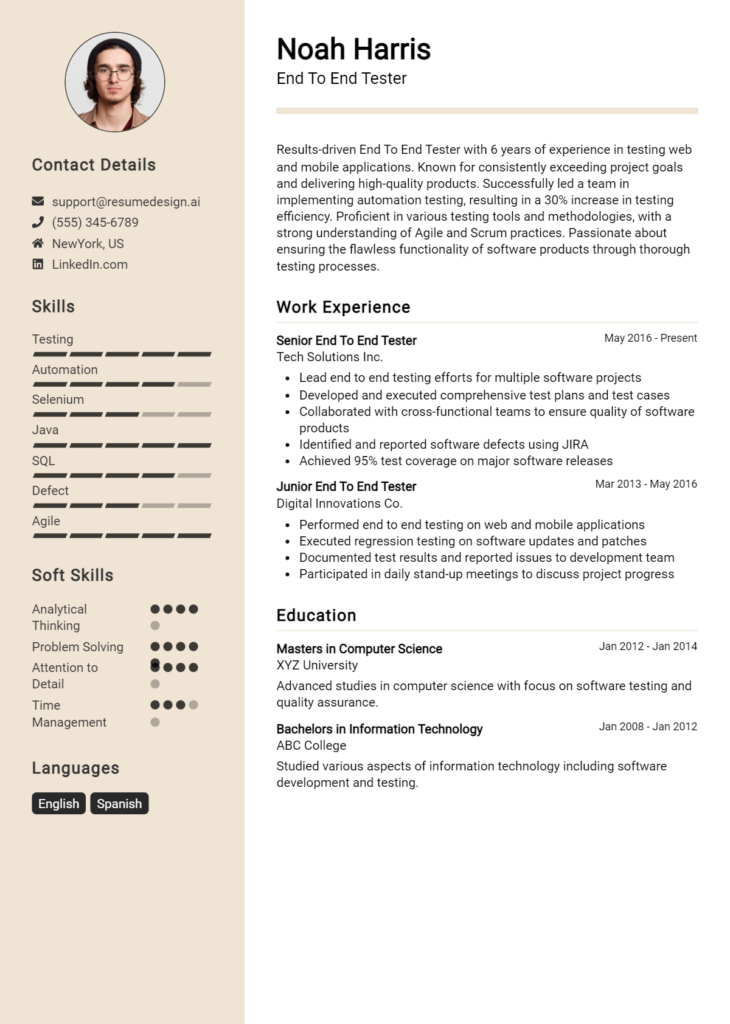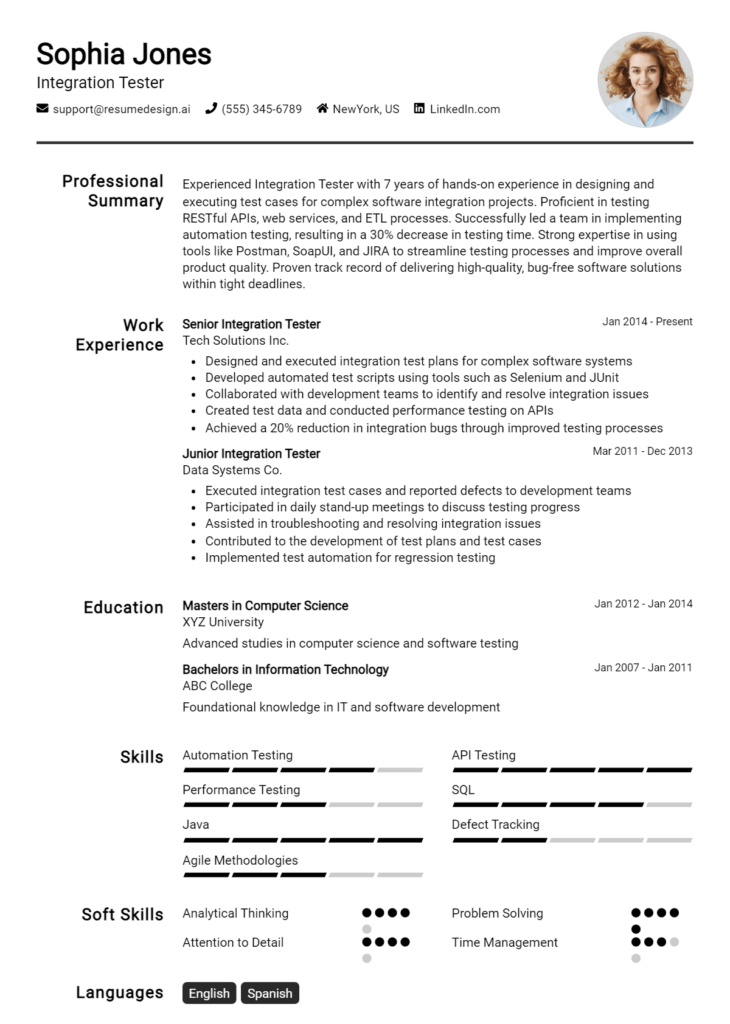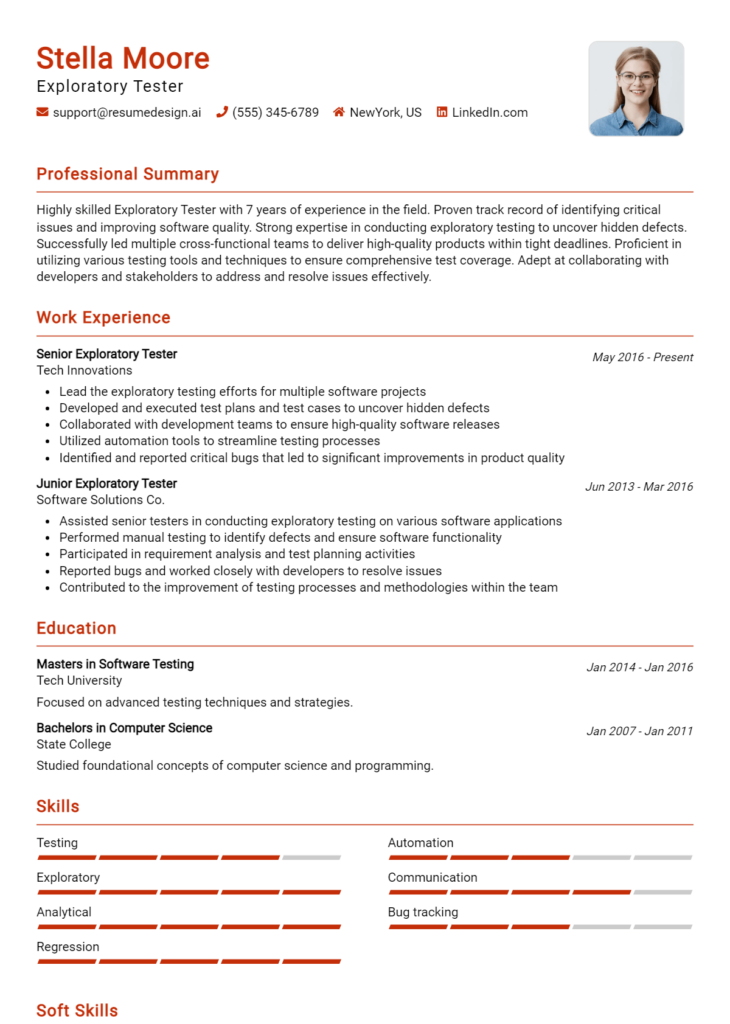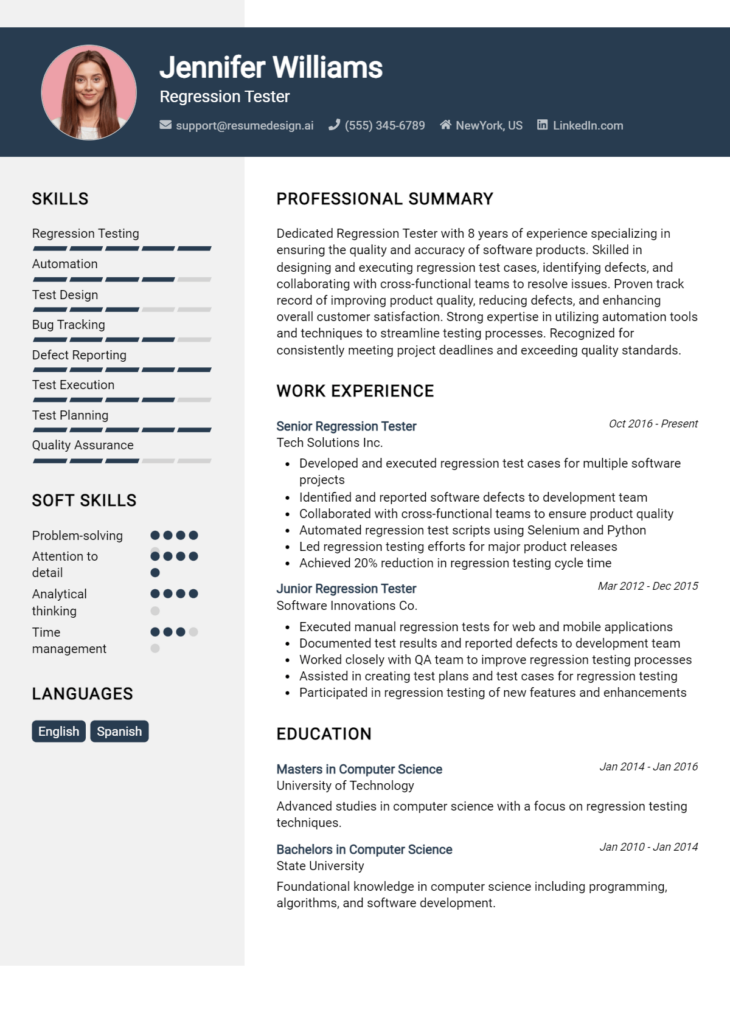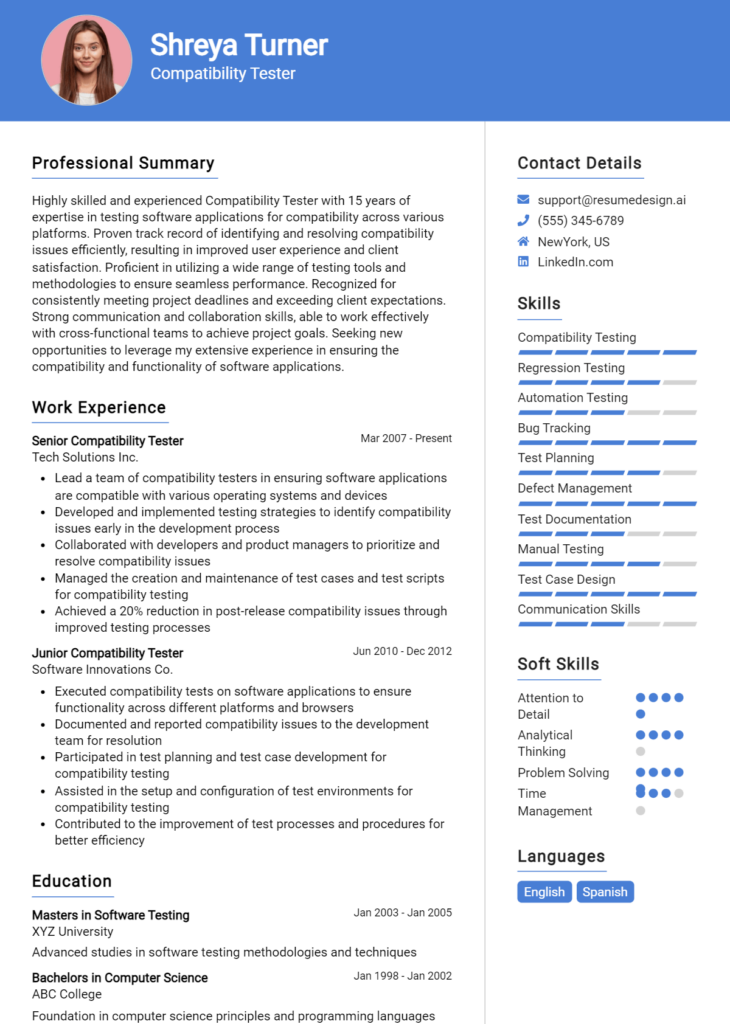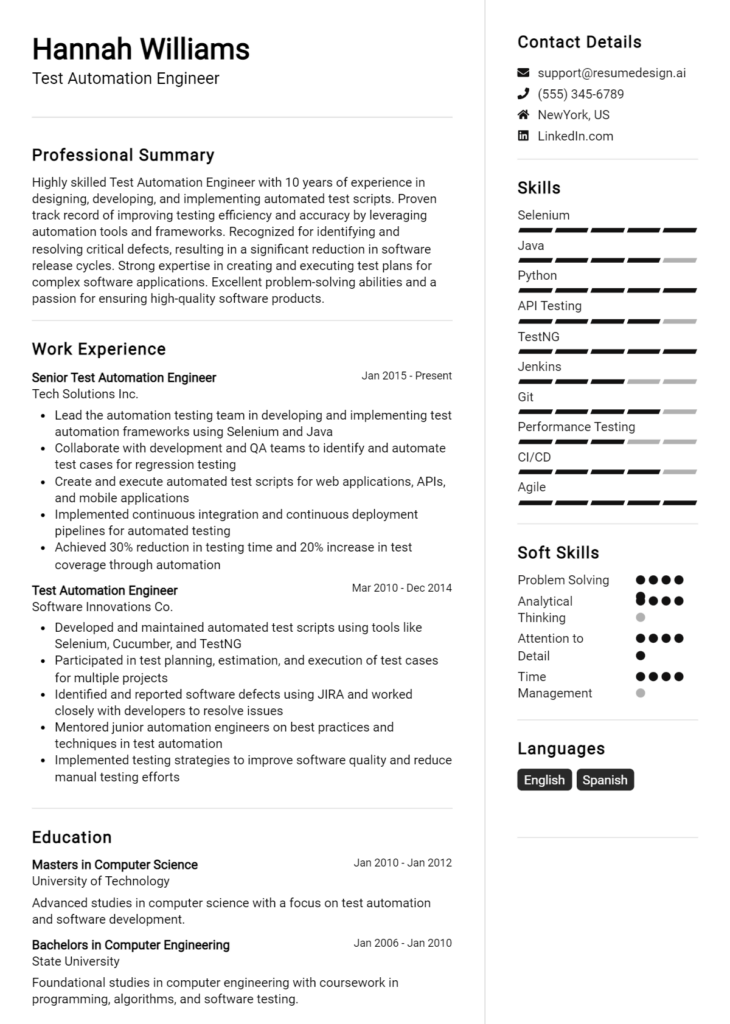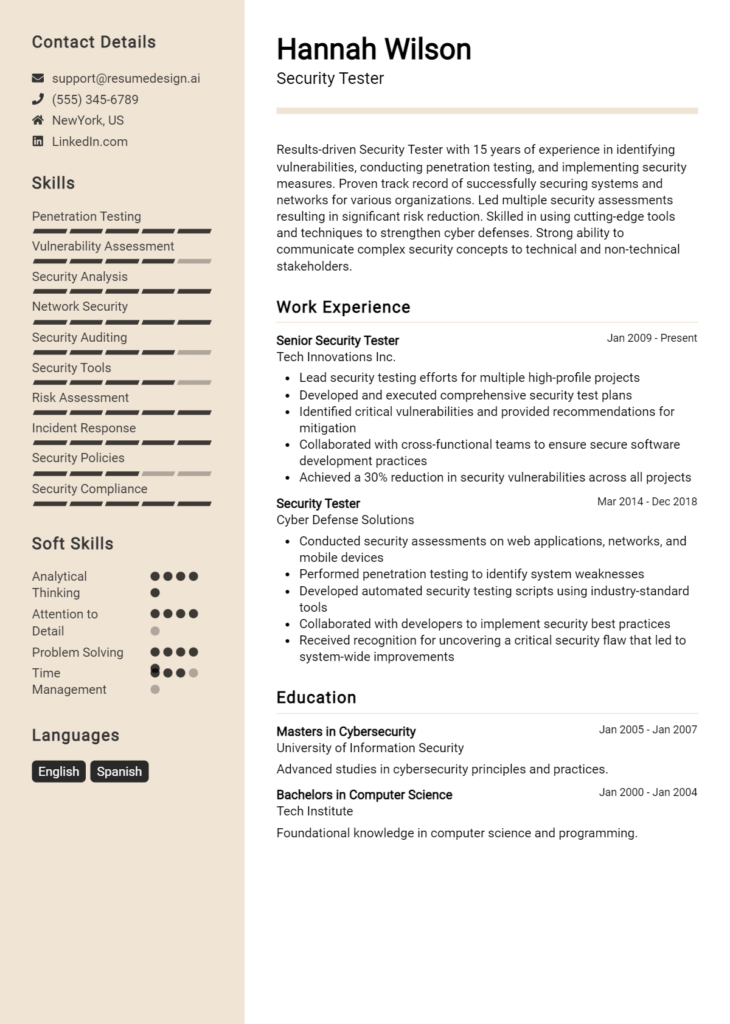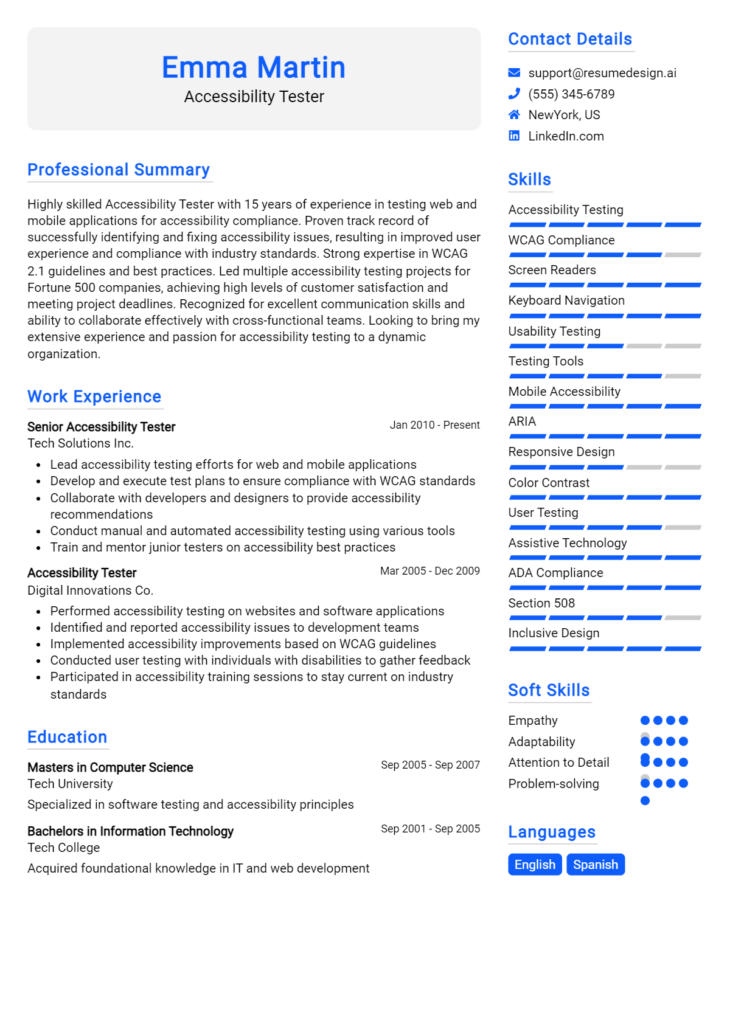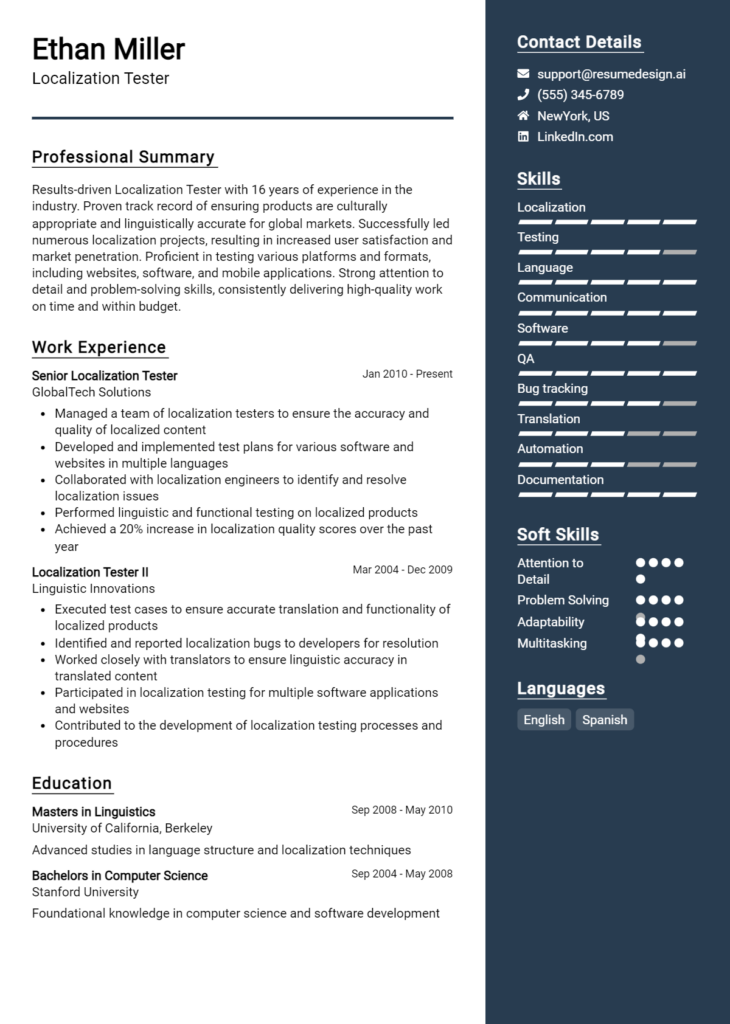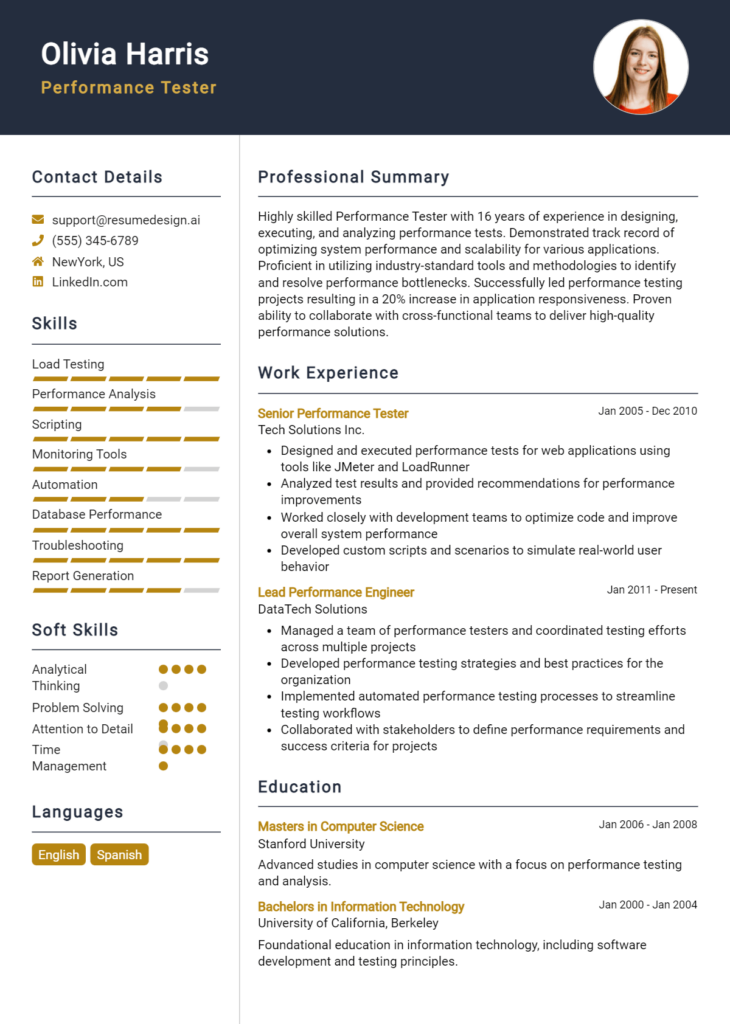Acceptance Tester Core Responsibilities
An Acceptance Tester plays a pivotal role in ensuring that software meets defined requirements and functions effectively across various departments. Key responsibilities include executing test cases, documenting results, and collaborating closely with developers, product managers, and quality assurance teams. Essential skills encompass technical proficiency, operational insight, and strong problem-solving abilities, all vital for identifying issues early and ensuring quality delivery. A well-structured resume can effectively highlight these competencies, showcasing how they contribute to the organization's success.
Common Responsibilities Listed on Acceptance Tester Resume
- Develop and execute comprehensive acceptance test plans.
- Collaborate with cross-functional teams to understand software requirements.
- Document and report defects, providing detailed feedback for improvements.
- Perform regression testing to ensure existing functionalities remain unaffected.
- Participate in requirement reviews and design discussions.
- Assist in user acceptance testing (UAT) with end-users.
- Utilize automated testing tools to streamline testing processes.
- Analyze test results and provide actionable insights to stakeholders.
- Maintain testing documentation and records for compliance purposes.
- Stay updated on industry trends and best practices in testing methodologies.
High-Level Resume Tips for Acceptance Tester Professionals
In today's competitive job market, a well-crafted resume is crucial for Acceptance Tester professionals seeking to make a strong first impression on potential employers. Your resume serves as a reflection of your skills, achievements, and professional journey, often determining whether you move forward in the hiring process. It is essential that your resume not only highlights your technical expertise but also showcases your ability to deliver quality results in software testing environments. This guide will provide practical and actionable resume tips specifically tailored for Acceptance Tester professionals, ensuring that you stand out to hiring managers and secure that coveted interview.
Top Resume Tips for Acceptance Tester Professionals
- Tailor your resume to the specific job description by incorporating relevant keywords and phrases from the posting.
- Highlight your experience with acceptance testing methodologies, including Agile and Waterfall, to demonstrate your versatility.
- Quantify your achievements, such as the number of test cases executed or the percentage of defects identified, to showcase your impact.
- Include industry-specific skills, such as familiarity with testing tools (e.g., Selenium, JIRA) and frameworks, to enhance your technical profile.
- Showcase any certifications related to software testing, such as ISTQB or CSTE, to validate your expertise.
- Use a clean, professional layout that is easy to read, ensuring that your key information stands out.
- Incorporate a summary statement at the top of your resume that succinctly encapsulates your experience and goals.
- Highlight collaborative experiences where you worked with developers and stakeholders to emphasize your teamwork and communication skills.
- List relevant projects you’ve contributed to, detailing your role and the outcomes achieved, to provide tangible evidence of your skills.
By implementing these tips, Acceptance Tester professionals can significantly enhance their resumes and improve their chances of landing a job in this field. A well-structured resume that accurately reflects your skills and accomplishments not only captures the attention of hiring managers but also positions you as a strong candidate ready to contribute to their team.
Why Resume Headlines & Titles are Important for Acceptance Tester
In the competitive field of software testing, the role of an Acceptance Tester is vital in ensuring that products meet specified requirements and are ready for release. As hiring managers sift through numerous applications, a well-crafted resume headline or title can serve as a powerful first impression. A strong headline encapsulates a candidate's core qualifications and sets the tone for the rest of the resume. It should be concise, relevant, and tailored to the specific job being applied for, allowing candidates to immediately communicate their value and expertise in acceptance testing.
Best Practices for Crafting Resume Headlines for Acceptance Tester
- Be concise: Aim for a headline that is no longer than 10 words.
- Focus on relevance: Tailor the headline to match the job description.
- Highlight key skills: Include specific skills that are in-demand for acceptance testing.
- Use action words: Start with dynamic verbs to convey a sense of proactivity.
- Showcase experience: Mention years of experience or significant achievements.
- Stay clear of jargon: Use language that is easily understood by hiring managers.
- Incorporate certifications: If applicable, include relevant credentials in the headline.
- Avoid generic phrases: Steer clear of vague terms that dilute your unique qualifications.
Example Resume Headlines for Acceptance Tester
Strong Resume Headlines
"Detail-Oriented Acceptance Tester with 5+ Years in Agile Environments"
"Certified Acceptance Tester Skilled in Automated Testing and Quality Assurance"
“Results-Driven Tester with Proven Success in User Acceptance Testing”
“Experienced QA Specialist with Expertise in Acceptance Criteria Development”
Weak Resume Headlines
“Tester Looking for New Opportunities”
“Experienced Professional in Software Testing”
The strong headlines are effective because they are specific, showcasing the candidate's unique skills, years of experience, and relevant achievements in acceptance testing. They immediately convey the candidate’s qualifications and their fit for the role. In contrast, the weak headlines fail to impress due to their vagueness and lack of detail; they do not provide hiring managers with any compelling information about the candidate's strengths or what sets them apart from others, ultimately making them forgettable in a sea of applications.
Writing an Exceptional Acceptance Tester Resume Summary
A well-crafted resume summary is crucial for an Acceptance Tester as it serves as the first impression to hiring managers. This brief yet impactful section quickly highlights the candidate's key skills, relevant experience, and notable accomplishments that align with the requirements of the job. A strong summary not only captures attention but also sets the tone for the rest of the resume, making it essential for candidates to be concise and tailored in their approach. By focusing on specific achievements and competencies, applicants can effectively position themselves as top contenders for the role.
Best Practices for Writing a Acceptance Tester Resume Summary
- Quantify achievements to provide measurable results (e.g., "Improved testing efficiency by 30%").
- Highlight key skills relevant to acceptance testing, such as knowledge of testing methodologies or tools.
- Tailor the summary to match the job description, incorporating specific keywords.
- Keep it concise, ideally between 2-4 sentences, to maintain the reader's attention.
- Focus on relevant experience, emphasizing roles that directly relate to acceptance testing.
- Showcase certifications or specialized training that enhance your qualifications.
- Use action verbs to convey a sense of proactivity and expertise.
- Reflect your career goals and how they align with the prospective employer's objectives.
Example Acceptance Tester Resume Summaries
Strong Resume Summaries
Detail-oriented Acceptance Tester with over 5 years of experience in software testing and quality assurance. Successfully identified and resolved over 200 critical bugs, enhancing software performance by 40%. Proficient in Agile methodologies and automated testing tools, contributing to a 25% reduction in project delivery timelines.
Results-driven Acceptance Tester with a proven track record of improving product quality through rigorous testing procedures. Led a team to implement a new testing framework that decreased testing cycles by 50%, ensuring timely releases. Skilled in both manual and automated testing techniques.
Experienced Acceptance Tester specializing in user acceptance testing (UAT) for enterprise applications. Collaborated with cross-functional teams to develop test plans and cases, achieving a 98% accuracy rate in defect detection. Certified in ISTQB and proficient in Selenium and JIRA.
Weak Resume Summaries
I have experience in testing software and I am looking for a job in this field.
Acceptance Tester with some knowledge of testing processes. I want to work for a company where I can improve my skills.
The strong resume summaries are effective because they provide specific, quantifiable results and directly relate to the Acceptance Tester role, showcasing the candidate's skills and accomplishments. In contrast, the weak summaries lack detail and specificity, making them vague and unmemorable, which may lead hiring managers to overlook these candidates.
Work Experience Section for Acceptance Tester Resume
The work experience section of an Acceptance Tester resume is critical as it demonstrates the candidate's technical skills, ability to manage teams, and commitment to delivering high-quality products. This section provides potential employers with a clear view of how the candidate has applied their knowledge in real-world scenarios, showcasing their problem-solving abilities and attention to detail. By quantifying achievements, such as the number of successful test cycles completed or the percentage of defects identified, candidates can illustrate their impact on previous projects. Aligning this experience with industry standards further enhances the resume's effectiveness, making it easier for hiring managers to recognize the candidate as a suitable fit for their organization.
Best Practices for Acceptance Tester Work Experience
- Highlight relevant technical skills and tools used in testing processes.
- Quantify achievements with specific metrics, such as defect rates or test coverage percentages.
- Emphasize collaboration with cross-functional teams, including developers and project managers.
- Detail leadership roles taken in projects or initiatives, showcasing team management skills.
- Use action verbs to describe contributions, making statements more impactful.
- Align work experience with industry standards and best practices for testing methodologies.
- Include relevant certifications or training that enhance credibility in the field.
- Tailor the work experience section to match the job description of the position applied for.
Example Work Experiences for Acceptance Tester
Strong Experiences
- Led a cross-functional team of 5 in executing over 200 acceptance test cases, resulting in a 30% reduction in production defects.
- Implemented automated testing tools that improved test coverage by 50%, accelerating the release cycle by two weeks.
- Collaborated with developers and stakeholders to define acceptance criteria, ensuring all requirements were met before product launch, leading to a 95% customer satisfaction rating.
- Trained and mentored junior testers, enhancing team efficiency and reducing onboarding time by 40%.
Weak Experiences
- Worked on various testing projects without specific details on contributions or outcomes.
- Participated in team meetings and discussions regarding testing.
- Assisted in testing tasks as directed by senior testers.
- Completed some testing activities for software applications.
The examples provided above illustrate the difference between strong and weak experiences in an Acceptance Tester resume. Strong experiences are characterized by quantifiable outcomes, clear demonstrations of leadership, and collaboration, showcasing the candidate's value and impact in previous roles. In contrast, weak experiences lack specific achievements and details, making it difficult for employers to gauge the candidate's skills and contributions effectively. This highlights the importance of presenting work experience in a compelling and measurable way.
Education and Certifications Section for Acceptance Tester Resume
The education and certifications section of an Acceptance Tester resume is vital for showcasing a candidate's academic foundation and commitment to professional development. This section serves as a platform to highlight relevant degrees, industry-recognized certifications, and specialized training that align with the role of an Acceptance Tester. By providing details on pertinent coursework and continuous learning endeavors, candidates can significantly enhance their credibility and demonstrate their readiness to meet the demands of the position.
Best Practices for Acceptance Tester Education and Certifications
- Focus on relevant degrees in fields such as Computer Science, Information Technology, or Software Engineering.
- List certifications that are recognized in the industry, such as ISTQB Certified Tester or Certified Agile Tester.
- Include any specialized training programs or workshops that pertain to acceptance testing methodologies.
- Provide detailed descriptions of coursework that directly relates to software testing, quality assurance, or project management.
- Clearly indicate the level of education (e.g., Bachelor’s, Master’s) to establish academic qualifications.
- Stay current by including recent certifications or courses that reflect ongoing professional development.
- Use clear formatting to ensure easy readability and highlight key information effectively.
- Tailor the section to align with the job description to demonstrate relevance to the specific role.
Example Education and Certifications for Acceptance Tester
Strong Examples
- Bachelor of Science in Computer Science, University of Technology, 2020
- ISTQB Certified Tester – Foundation Level, 2021
- Certified Agile Tester (CAT), 2022
- Coursework in Software Quality Assurance and Testing Strategies, XYZ Online Academy, 2023
Weak Examples
- Associate Degree in Culinary Arts, 2018
- Certification in Microsoft Office Suite, 2019
- High School Diploma, 2015
- Old certification in Manual Testing Techniques from 2015 (no longer relevant)
The strong examples are considered effective because they directly relate to the skills and knowledge required for an Acceptance Tester, showcasing relevant degrees and certifications that emphasize a commitment to the field. In contrast, the weak examples lack relevance to the role, featuring outdated or unrelated educational qualifications that do not support the candidate's candidacy for an Acceptance Tester position.
Top Skills & Keywords for Acceptance Tester Resume
As an Acceptance Tester, showcasing your skills on your resume is crucial for standing out in a competitive job market. These skills not only demonstrate your technical expertise and problem-solving abilities but also highlight your capacity to work collaboratively with development teams and stakeholders. A well-crafted resume that emphasizes both hard and soft skills can significantly impact your chances of landing an interview. Recruiters often look for specific qualifications that align with the requirements of the role, making it essential to tailor your resume accordingly. By focusing on the relevant skills, you can effectively present yourself as a qualified candidate ready to contribute to quality assurance and user satisfaction.
Top Hard & Soft Skills for Acceptance Tester
Soft Skills
- Attention to Detail
- Critical Thinking
- Communication Skills
- Collaboration
- Problem-Solving
- Adaptability
- Time Management
- Analytical Skills
- Conflict Resolution
- Empathy
- Creativity
- Patience
- Leadership
- Decision-Making
- Interpersonal Skills
Hard Skills
- Familiarity with Testing Frameworks
- Knowledge of Software Development Life Cycle (SDLC)
- Proficiency in Test Case Design
- Experience with Bug Tracking Tools (e.g., JIRA)
- Ability to Write Test Plans
- Understanding of Automation Testing Tools (e.g., Selenium)
- Knowledge of Performance Testing
- Experience with User Acceptance Testing (UAT)
- Familiarity with SQL for Database Testing
- Proficiency in Creating Test Scripts
- Understanding of Agile Methodologies
- Knowledge of API Testing
- Experience with Version Control Systems (e.g., Git)
- Familiarity with Continuous Integration/Continuous Deployment (CI/CD)
- Proficiency in using Testing Management Tools
- Understanding of Usability Testing
- Ability to Analyze Test Results
- Knowledge of Security Testing Techniques
Incorporating these skills into your resume, along with relevant work experience, will enhance your appeal to potential employers and increase your chances of securing a position as an Acceptance Tester.
Stand Out with a Winning Acceptance Tester Cover Letter
Dear [Hiring Manager's Name],
I am excited to apply for the Acceptance Tester position at [Company Name] as advertised on [where you found the job listing]. With a strong background in software testing and quality assurance, combined with my passion for ensuring that products meet user requirements and expectations, I am confident in my ability to contribute effectively to your team. I have honed my skills in developing test cases, executing acceptance tests, and collaborating with cross-functional teams to ensure that deliverables meet the highest standards of quality.
In my previous role at [Previous Company Name], I successfully implemented a structured acceptance testing process that reduced post-deployment defects by over 30%. I worked closely with stakeholders to gather requirements and translate them into comprehensive test scenarios. My attention to detail and analytical mindset allowed me to identify potential issues before they reached production, ultimately enhancing user satisfaction and trust in our products. I am adept at using various testing tools and methodologies, and I am always eager to learn and adapt to new technologies and processes.
I am particularly drawn to the opportunity at [Company Name] because of your commitment to innovation and quality. I admire your approach to user-centric design and believe that my experience in advocating for end-users during the testing process aligns perfectly with your values. I am excited about the possibility of contributing to your team's efforts in delivering exceptional software solutions that not only meet but exceed customer expectations.
Thank you for considering my application. I look forward to the opportunity to discuss how my skills and experiences align with the needs of your team. I am eager to bring my expertise in acceptance testing to [Company Name] and help ensure that your products provide the best possible experience for users.
Sincerely,
[Your Name]
[Your Contact Information]
Common Mistakes to Avoid in a Acceptance Tester Resume
When crafting a resume for the role of an Acceptance Tester, it's essential to present your skills and experience effectively to stand out in a competitive job market. However, many candidates make common mistakes that can hinder their chances of landing an interview. By avoiding these pitfalls, you can create a more compelling resume that showcases your qualifications and expertise in acceptance testing.
Neglecting to Tailor the Resume: Failing to customize your resume for each specific job application can make it seem generic. Highlight relevant skills and experiences that align with the job description.
Using Jargon Without Explanation: While industry terminology is important, overusing jargon without context can confuse hiring managers. Ensure that technical terms are explained or used in a way that demonstrates your understanding.
Omitting Key Skills: Acceptance testing requires a unique set of skills, such as knowledge of testing methodologies and tools. Be sure to include both hard and soft skills relevant to the role.
Being Vague About Achievements: Instead of listing responsibilities, quantify your achievements with specific examples. For instance, mention how your testing led to a reduction in bugs by a certain percentage.
Ignoring Formatting and Readability: A cluttered or poorly formatted resume can detract from the content. Use clear headings, bullet points, and consistent fonts to enhance readability.
Listing Irrelevant Work Experience: Including jobs that do not relate to acceptance testing can dilute your resume's impact. Focus on positions that showcase relevant experience and skills.
Using Passive Language: Active language makes your contributions more impactful. Instead of saying "was responsible for testing," use phrases like "conducted comprehensive acceptance testing."
Overlooking Proofreading: Spelling and grammatical errors can undermine your professionalism. Always proofread your resume or consider having someone else review it to catch any mistakes.
Conclusion
As an Acceptance Tester, your role is critical in ensuring that software products meet the required standards before they are released to users. This involves developing and executing test plans, identifying defects, and collaborating closely with development teams to ensure quality assurance throughout the software development lifecycle. Key skills include attention to detail, analytical thinking, and effective communication. It’s also important to stay updated on testing methodologies and tools to improve the efficiency and effectiveness of your testing processes.
In conclusion, if you're looking to elevate your career as an Acceptance Tester, now is the time to review and refine your resume. Highlight your relevant experiences, skills, and accomplishments to stand out in the competitive job market. To assist you in this process, make use of available resources such as resume templates, resume builder, resume examples, and cover letter templates. Take action today to create a compelling resume that showcases your qualifications and readiness for your next opportunity!

